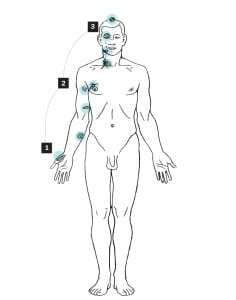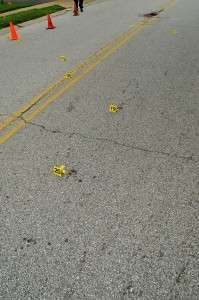The Volokh Conspiracy
Mostly law professors | Sometimes contrarian | Often libertarian | Always independent
The physical evidence in the Michael Brown case supported the officer [updated with DNA evidence]
In the wake of the Michael Brown grand jury decision, several blog posts (including one by me Wednesday) have dissected Officer Darren Wilson's testimony. Read by itself, different people can draw differing conclusions about whether it is accurate or not. But what hasn't been widely discussed is whether the physical evidence confirms or contradicts his story.
Perhaps the reason for this disinterest in the ballistics report, autopsies and other similar information is that for at least some of Brown's supporters the facts are, apparently, largely irrelevant because Brown is a metaphorical "symbol" of injustice regardless of what actually happened. A related reason may be that working through this information is time-consuming - and thus beyond the capacity of many commentators. In contrast, the grand jury painstakingly heard sworn testimony from more than 60 witnesses, which is now collected in several thousand pages of transcripts. Reviewing these transcripts reveals some important and essentially indisputable facts. And those facts confirm many critical aspects of Wilson's account.
http://www.washingtonpost.com/posttv/national/full-grand-jury-announcement-on-darren-wilson/2014/11/24/9824259c-744f-11e4-8893-97bf0c02cc5f_video.html
The Washington Post has this extremely helpful graphical presentation of what happened during the shooting, with links to some of the physical evidence in the case. What follows is my discussion of what appears to be some of the most significant. To be clear, I do not purport here to completely describe all the forensic evidence and related testimony. But I will commit to carefully reviewing all of the comments to this post and if anyone points to a significant omission in what I'm describing about the physical evidence - and provides a citation to the volume and page number of the grand jury testimony for that omission - I'll be glad to consider adding discussion of it. This post is limited to discussing the physical evidence, as witness testimony cuts in many different directions.
As those who have been following the case closely are aware, Wilson testified before the grand jury that Brown reached for his (Wilson's) gun and a struggle for the gun followed, during which Wilson fired two shots. Later, Wilson pursued Brown and, after he turned and then charged toward Wilson, fired multiple shots bringing him to the ground about 8 to 10 feet away from him.
The physical evidence is consistent with his testimony. The County Medical Examiner was one of the first witnesses to testify before the grand jury. He explained the autopsy he conducted on Brown. It will be useful to show the injuries discussed and, for these purposes, I insert a chart prepared by an examiner hired by Brown's family. (The parallel chart from the ME has not been publicly released, although the ME's testimony has been released).

The ME found a tangential injury on Brown's right thumb that traveled along the surface of the thumb - grand jury testimony Volume 3 (Sept. 9), page 114, line 12 etc. (hereafter cited by just page and line number). The ME further explained that he saw what appeared to be "soot" in the wound, which was consistent with a shot from close range (116:22). Indeed, based on his training and expertise, the ME thought that the soot would be indicative of the gun that fired the bullet causing the wound having been only 6 to 9 inches away (118:12). The soot was consistent with that discharged from a gun (122:13). The official report from the Office of Medical Examiner later confirmed that "the previously described particles of foreign particulate matter are consistent with products that are discharged from the barrel of a firearm."
The significance of this wound and related physical evidence is that it places Brown's right hand within 6 to 9 inches of the barrel of Wilson's firearm. This physical evidence is thus quite consistent with Wilson's testimony that Brown was trying to get hold of Wilson's weapon, creating a fear in Wilson that he was going to get shot. It also creates a problem for those who view Brown as having been somehow accosted by Wilson and was just trying to escape. At least in the theories that I have seen sketched out, no explanation is offered for why Brown (who weighed around 300 pounds) had been forced by Wilson to have his right hand in a position where it was close to the gun and inside Wilson's police car.
At some point in the altercation, it appears undisputed that Brown (and his friend Dorian Johnson) ran away from Wilson. Wilson pursued on foot and, according to Wilson, Brown eventually paused, turned around, and then charged at him.
The ME's testimony also aligns with Wilson's testimony on this point. The ME found various wounds to Brown's arms, upper torso, and head. Focusing on the head wounds, a detailed report and summary report from the Office of the Medical Examiner indicated that one wound with an entrance to the vertex of Brown's head was "downward and rightward" (detailed report at p. 2) and the wound with an entrance to central forehead was "downward, slightly backward, and rightward" (summary p. 1). The report also describes the entrance to the wounds on Michael Brown's chest as "downward" or "slightly downward" (id.).
The ME explicated these findings at great length to the grand jurors. He explained that the entry direction for the head wounds, for example, was "slightly downward" (157:6). The earlier wounds would not have been disabling (151:1) and would not have been disabling in combination, until the final wound to the top of the head (159:15). In the ME's opinion, the first wound was the wound to the thumb, the last was the wound to the top of Brown's head (197:7). The ME specifically testified that if Brown was bent over, that would be consistent with the entry to the head wounds, although he cautioned that he could not say for certain what position Brown was in at the time he received the wound (166:11).
Perhaps most important, the ME carefully explained how he was able to identify entry points and exit points for the wounds to Brown. With regard to the wounds on the torso and head, there were no wounds from the back (197:18). With regard to the arms, there was only one injury that was from the back - an injury to "the posterior portion of the right forearm" (198:25). The ME indicated that it is extremely difficult to identify, from bullet wounds, the position of the arms at the time of a shot because "you've got . . . an elbow joint, you have a shoulder joint and then the wrist, you have a lot of mobility within that arm and it can be in a lot of scenarios" (133:11).
Here again, this testimony was consistent with Wilson's testimony. It aligned with Brown charging forward toward Wilson, coming to a halt only when Wilson was able to get a fatal shot to the head. Significantly, the ME's testimony did not align with those who claimed (before the grand jury or in the media) the Wilson had gunned Brown down in the back.
The grand jury also heard testimony about a second, independent autopsy performed by an forensic expert hired by the Brown family, Michael Baden. Baden testified that his findings were the same as the ME's (Vol. 23, at 108:1). With regard to the thumb wound suffered by Brown, he concluded that the thumb was just a "few inches" away from Wilson's gun. He praised the work of a technician who had found in Wilson's car skin tissue that appeared to be from Michael Brown's thumb (72:20). Baden also found that Brown's head was down when the shots were fired (71:2). (In one curious recent note, the pathology assistant heavily involved with Baden's work was apparently a fraud, as reported in just the last few days by CNN).
Baden also discussed the significance of a positive finding from the toxicology report conducted on Brown that came back positive for cannabinoids - specifically, THC in a concentration level that Baden described as "relatively small" (79:11). Baden did, however, report that "the amount of marijuana that [Brown] has in his system could cause abnormal behavior, but usually doesn't. The best indicator of that would be what his behavior was in the time period before . . . Was he walking in the street because of marijuana? That isn't usually what happens with marijuana, but it could be and it is too variable" (80:5).
In addition to the autopsy information, the grand jury was also presented with ballistics information. The crime scene detective presented the location of shell casings and other evidence recovered after the shooting. The locations of the recovered evidence was also marked, as depicted in the adjacent photograph.

All of the evidence is conveniently identified on this chart by The Post (developed from a chart presented to the grand jury).
Of particular interest for evaluating Wilson's testimony is the location of the 12 shell casings recovered. Two of them were recovered close to Wilson's car, conforming to his testimony about his firing two shots there (vol. V, 226:4). After that, the remaining 10 casings were recovered adjacent to (or behind) the path that Wilson said Brown took when charging toward him. This was consistent with Wilson firing a series of shots as Brown rushed toward him, all the while backpedaling to try and increase the distance.
These are the highlights of the physical evidence that I have reviewed in the case, compared to Wilson's testimony. Based on my initial read, so far as I can see there are no significant inconsistencies between the physical evidence and Wilson's grand jury testimony. Other reviews have likewise not identified readily-apparent examples of problems with Wilson's testimony. For example, a review of the grand jury testimony by three Associated Press reporters noted numerous examples of witness statements inconsistent with the physical evidence, but offered no examples from Wilson's testimony.
The physical evidence is important because, unlike witness testimony, it doesn't lie and can't be accused of bias (such as racism). As the cliche goes, the physical evidence is what it is. In this case, the physical evidence aligned with Wilson's testimony. To be sure, as my co-blogger Orin properly cautioned earlier this week, it is always possible for a potential target in criminal case to lie before a grand jury. But it is also possible for him to tell the truth. The grand jury had to sort out these competing possibilities - and the physical evidence gave no reason to doubt Wilson's testimony.
Update: Several readers have helped me locate some additional, significant evidence confirming that Michael Brown was extremely close to Officer Wilson's gun. An expert in DNA from the St. Louis County Police Department Crime Law testified that Michael Brown's DNA was later found on Wilson's firearm. (Vol. 19, 182:16). It was not possible to determine whether this was due to contact with Brown's skin, blood, or some other bodily fluid. The interior left front door panel of Wilson's car also had DNA from Michael Brown on it (185:9). On the other hand, the DNA expert did not find Wilson's DNA on Michael Brown's shirt (191:15).
Further update: Commenter Mark Spoo, while questioning me about a few of my conclusions, has also helpfully alerted me to this detailed index of the grand jury testimony from the St. Louis Post-Dispatch.


Show Comments (0)